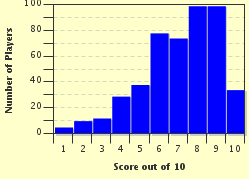Quiz Answer Key and Fun Facts
1. You shift the goat's horn, a keffiyeh and shards of a pottery jar (complete with some grains of sand), to get a closer look at the manuscript paper lying underneath some glass. The writing looks ancient. The label indicates that it is an obsolete title deed for a local ironmongery shop. I don't think so. What does the photo actually show?
2. Moving aside the used bandage and a toy pistol sitting on a Victorian-era table in front, you can get a good look at this painting with its "Vincent" signature. The label indicates that the painting of daisies is by a retired librarian called Vincent. I don't think so. What does the photo actually show?
3. Next to the models of the red telephone box and the TARDIS-style blue police box, you find a bowl of used stamps at give-away prices. Sifting through these, you recognise a fine copy of the world's first self-adhesive postage stamp. Which country issued this stamp?
4. Next to the replica Charles Rennie Mackintosh chair sits a coffee table with tartan teapot and a collection of miscellaneous games pieces set out on a chequered board. The label encourages you to make up a set from the various mismatched pieces. You notice that two pieces, made of walrus ivory, are a bit out of place amongst the other wooden and plastic pieces. In which European chain of islands were they found?
5. Hidden amongst a miscellany of items including a set of dentures, a clipping about a child cutting down a cherry tree and a copy of the US Constitution, you find a medal. Whose image is shown on it?
6. Now you are browsing through the contents of a desktop. There's an appointment card for a dentist called Paul Revere, a newspaper clipping dating from 1773 about a dockside tea party and a 1978 LP titled "Don't Look Back"; however the gem in this section is a worn baseball signed by a record-breaker. Which team did the bigger hitter start his record-breaking career with?
7. Sifting through a pile of foreign coins being sold off cheap, you come across one that is a bit heavier than most. You notice the animal on the coin (see the photo) is also the nickname for this country's rugby team. Which country is this?
8. You open a few drawers in a desk and find a box with a brass label inscribed "Negretti & Zambra", as you can see in the photo. Inside is a compass marked "Edward VII Compass King & Emperor 1908". It also has the Robert Frost poem "The Road Not Taken" engraved on the inside of the cover. Where was the compass made?
9. A trawl through a bucket of obsolete foreign currency notes produces this gem from 2008. A billion dollars! Will this make you rich?
10. Your eye is drawn to a misplaced LP - John Denver's "Back Home Again": what was the hit single off that one again? The asking price is a bargain, making you think of that expression. Then you notice it is leaning against a nondescript-looking porcelain vase with a crazed green glaze. The label indicates that it comes from the local art school. An amateur effort. I don't think so. In fact it is Chinese and possibly a thousand years old, but which period does it come from?
Source: Author
suomy
This quiz was reviewed by FunTrivia editor
Pagiedamon before going online.
Any errors found in FunTrivia content are routinely corrected through our feedback system.

